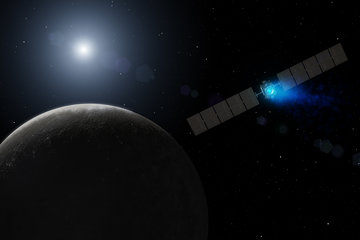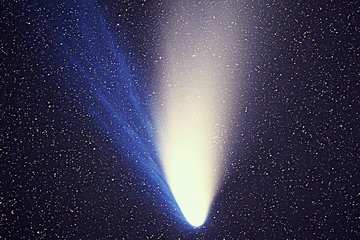Philae lander goes to sleep
Because of empty batteries, the activities on the comet will have be stopped until further notification. A chronology of the spectactular mission.
November 12, 2014 went down in history. On that day, an unmanned probe landed on a comet nucleus for the first time ever. Philae was to remain there as a permanent research station to collect data and take measurements for at least 60 hours. However, the final leg on its way to 67P/Churyumov-Gerasimenko was not without complications, as Philae bounced off the surface twice. Its exact location remained unknown. Nevertheless all board instruments were put into operation, and Philae managed to send a stream of data back to Earth before losing power. In the night to November 15, Philae automatically went into a deep sleep mode.
Text: Helmut Hornung
Already on 8 November, the ground crew sent the computer sequence that controlled the landing to Philae via the orbiter. On Monday, the lander was switched on and heated. On the morning of 12 November, the mother spacecraft Rosetta hovered just over 22 kilometres above the powdery surface of the comet 67P/Churyumov-Gerasimenko.

Between 7.35 and 8.35 CET, the final 'go' was given by the ground control centre. Experts of the European Space Agency had checked once again whether Rosetta's orbit was correct. Even though there were problems with the lander cold gas system, which was supposed to push Philae gently onto the comet surface after landing, the decision was made to separate as scheduled. Three preloaded springs manoeuvred Philae into space with a push 9.35 CET. The refrigerator-sized box drifted away from the mother ship.
At 10.03 CET the control centre ESOC in Darmstadt confirmed the successful separation. Approximately two hours after the separation, data transfer began. The lander sent signals to the orbiter, from which they travelled to earth at the speed of light. Because the comet is flying through space at a distance of 500 million kilometres from our planet, the signals took 28 minutes and 20 second to reach us. They reached ESOC at 12.07 CET.
With this delay, the researchers and technicians already gathered information on the status of Philae during the descent. Around 12.25 CET it was confirmed that the three landing legs and a sensor had been deployed. Moreover, first pictures of the onboard camera CIVA should soon arrive and measurements from instruments such as the radio radar CONSERT be transferred.
During the descent, Philae itself could not be controlled from Earth. Rather, the 100 kg mass spacecraft drifted in free fall towards the comet's nucleus at the speed of 18 centimetres per second. The landing area - recently christened Agilkia after a naming contest by ESA - was imprecise; the landing ellipse had an area of more than half a square kilometre. Due to the precise separation manoeuvre, Philae was exactly on course; the diameter of the landing ellipse had been reduced to 400 metres.

Roughly two hours after separation, Rosetta's onboard OSIRIS camera system was looking at the departing lander. "Philae is on a good way," Hermann Böhnhardt from the MPI for Solar System Research, lead scientist of the landing mission, commented. As evidenced by the most recent image, the lander had also successfully unfolded its legs. "To be able to watch this historic landing through the eyes of our camera is a feeling that cannot be described in words," says Max Planck Researcher Holger Sierks, leader of the OSIRIS team. "Since Rosetta's launch more than ten years ago, we have not seen any images of the lander. Now it is floating freely in space on its way to the comet's surface".
Only three kilometres separate Philae from the surface of the comet. The probe is equipped with a camera system that takes a picture of the landing site.
16.34 h CET: Touchdown, Philae has landed! The probe touched down at a rate of about one kilometre an hour. At this point, two explosive harpoons should have been fired into the surface, and, in addition, screw-like tips under the footpads of the three legs of the lander should have drilled into the comet's crust. A shock absorbing mechanism in the central cavity of the landing gear was supposed to absorb the energy and ensure that Philae woould not bounce into space. This, however, is precisely what happened.
At 17.03 CET, signals were received by control. The initial message was that landing was successful! However, the two harpoons which were meant to attach the probe firmly to the ground were not fired. So far, the reasons are a matter of speculation. In any case, this misoperation had fatal consequences.
When the lander team began interpreting the data it had received from Philae trying to reconstruct the exact goings-on during landing, it became evident that the probel must have bounced off twice after the initial touchdown. On November 13, Stephan Ulamec, Philae project manager at the German Aerospace Center, spoke of "three landings on one day".
The scenario was described in detail at the press conference. Thus, Philae appears to have first touched the surface relatively precisely in the intended landing area before taking off again to hover for about one kilometre across the comet’s nucleus and then land again. Then, the last “bounce” took Philae only another short distance away, before it finally came to rest.
The precise spot of landing is still unknown to the researchers. It is also possible that only two of Philae’s three legs stand on the ground. The first images show rocky material and a cliff. Only little sunlight appears to reach the place of landing. Owing to the primary battery, the onboard instruments still record data and take measurements.
Already before the landing it was clear that the greatest danger for Philae would be offered by the terrain itself. Chunks on the surface or a slope could have affected the landing even more than it appears to have been the case. If one of the legs of the probe had landed on a rock or a slope, and if the slope had been inclined by more than 30 degrees, Philae could have rolled off - which would probably have meant the end of the mission.
If one of the legs of the probe had landed on a rock or a slope, and if the slope had been inclined by more than 30 degrees, Philae could have rolled off - which would probably have meant the end of the mission.

The engineers and researchers had originally hoped that with normal power supply, the probe would be in operation for some weeks or even months. This hope was not fulfilled: Although controllers at the German Aerospace Center (DLR) in Cologne succeeded in communicating once again with the lander in the late evening of 14 November, to retrieve data and rotate it about 35 degrees, Philae's power supply was soon drained and the plucky lander was shut down - about two and a half days after the landing.
The scientists regard it as a great success that they were able to take all instruments on board into operation during this time, even the drill, which should have drilled 20 centimeters into the comet's surface. Because the landing site receives only one and a half hours of sunlight instead of the required six, Philae merely operated on primary battery power. The battery's life span, however, was limited to about 60 hours. That was also how long the "hot phase" of scientific work lasted.
After that time, Philae was automatically put into a deep sleep mode. The lander will only log in again when it has recharged enough energy. For this to occur, the comet must move closer towards the sun. "This will not happen within the next two months," said the technical director of the mission, Koen Geurts of the DLR control centre. In the worst case, Philae will be silent forever.














